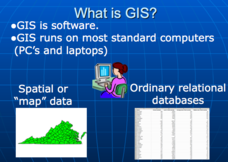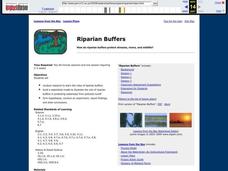Curated OER
Rivers & Watersheds
An outstanding presentation of rivers and watersheds awaits your earth scientists! The erosion process created by rivers is addressed. Viewers are introduced to v-shaped valleys, alluvial fans, and watersheds. Several slides are...
Curated OER
Wild and Wetlands
Upper graders identify the major characteristics of a wetland. They explore the human factors that change a wetland and write a descriptive paragraph about wetlands. This comprehensive lesson also has an interactive "Watershed Game"...
Curated OER
Chesapeake Bay
The Chesapeake Bay is the largest estuary in the United States. Explore its origins, organisms, and contributing rivers with this PowerPoint. It opens with several slides of general information on the formation of estuaries, then it...
Curated OER
Journey of a Raindrop to the Chesapeake Bay
Students explore the water cycle and the path a single drop of water would take if it traveled from their schoolyard to the Chesapeake Bay in Virginia.
NASA
The Case of the Wacky Water Cycle
Join the tree house detectives in learning about the processes of the water cycle, water conservation, water treatment, and water as a limited resource.
Curated OER
Marvelous Marshes of the Chesapeake
Third graders identify sources of salt water and fresh water that enter the Chesapeake Bay. They build a model watershed and describe how runoff enters the Bay.
Curated OER
Applications of GIS
Don't be concerned that the title slide of this presentation mentions Virginia's Geospatial Extension Program; this slide show is very informative for any technology-focused curriculum when considering global information systems. It...
Curated OER
Riparian Buffers
Students research the roles of riparian buffers and create a model that shows the role of the buffers in protecting waterways from pollution. They conduct an experiment from which they record their data in this unit which is spread over...
Curated OER
Types of Pollution
Students differentiate between various types of water pollution and complete a Venn diagram with the information. They consider why there are laws regulating the release of pollution in water and discuss solutions to pollution problems.
Curated OER
Native vs. Non-native Species: Who Will Win?
Students examine non-native species and the problems they have caused in the waters of the Chesapeake Bay. They create a "Wanted" poster for one of the species. They describe the effects of non-native species on the schoolyard species.
Curated OER
Who Killed SAV?
Students research the factors that contributed to the decline of submerged aquatic vegetation in the Chesapeake Bay. Students evaluate the natural and human factors that led to the decline of bay grasses.
Curated OER
Captain John Smith's Chesapeake Bay
Students conduct research to determine how the Chesapeake Bay has changed since the 17th century when Captain John Smith first explored it. Students read from Smith's historical documents.
Curated OER
Wasting Water
Students participate in a hands-on experiment to discover why it is important to conserve water and explore common ways water is wasted. Students estimate the volume of water available on earth and calculate the volumes and costs of...
Curated OER
Should New Orleans be Rebuilt?
Pupils, after researching two websites dealing with New Orleans, complete a chart as they read the arguments for and against rebuilding New Orleans. They locate the evidence offered for support, analyze the geography domains and identify...
Curated OER
Trout In The Classroom
Learners have trout in their classroom and complete journaling, checklists, temperature checking, and ammonia level recording. In this trout lesson plan, take weekly observation records of their trout.














